Ultimate Guide to B2B Sales Pipeline Stages: Close Deals Faster
Everything you need to know about B2B sales pipeline stages. From what a sales pipeline is to how to design your own pipeline, we've got you covered.
— Propoze
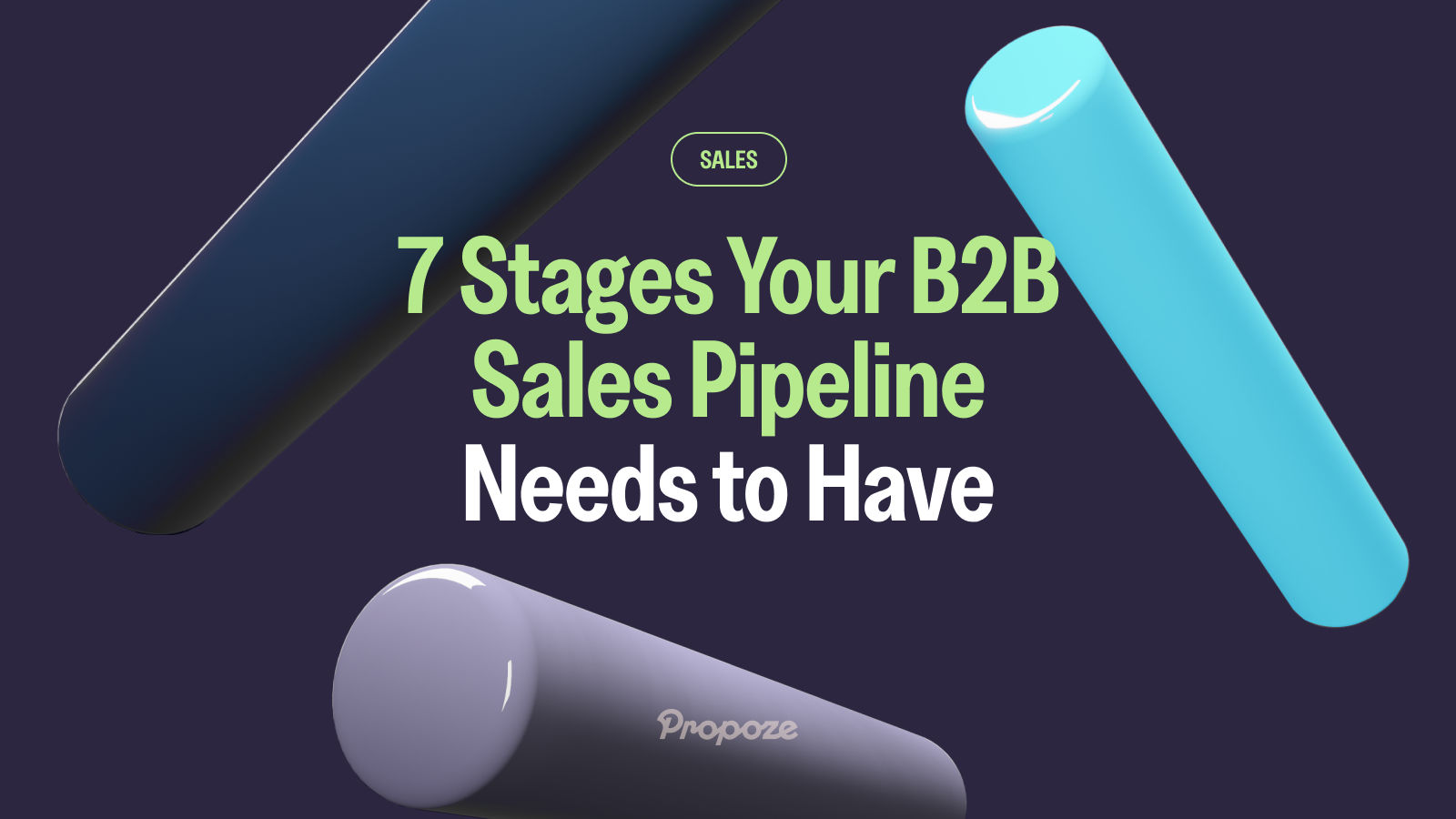
Sales is the lifeblood of any business. Without a steady stream of leads and sales, it's difficult for companies to grow and thrive. That's where your B2B sales pipeline comes in.
A well-designed sales pipeline can help businesses manage and track their sales process, from lead generation to closing deals and beyond.
In this blog post, we'll take a closer look at what a B2B sales pipeline management is, how to design one for your business, the must-have stages, and how to measure your success.
Whether you're a small business owner, a sales rep, or a freelancer managing your own sales, this short guide will help you build a B2B sales pipeline that drives revenue.
What is a sales pipeline?
A healthy sales pipeline is a systematic and visual approach to tracking potential customers and where they are in the sales process, from initial contact to closing the deal. It allows sales reps and sales leaders to manage and monitor their progress efficiently, identify potential roadblocks, and prioritize their efforts to close deals effectively.
A healthy pipeline typically includes stages, such as lead generation, lead qualification, proposal, negotiation, and closing, with each pipeline stage playing a crucial role in managing and optimizing the sales process.
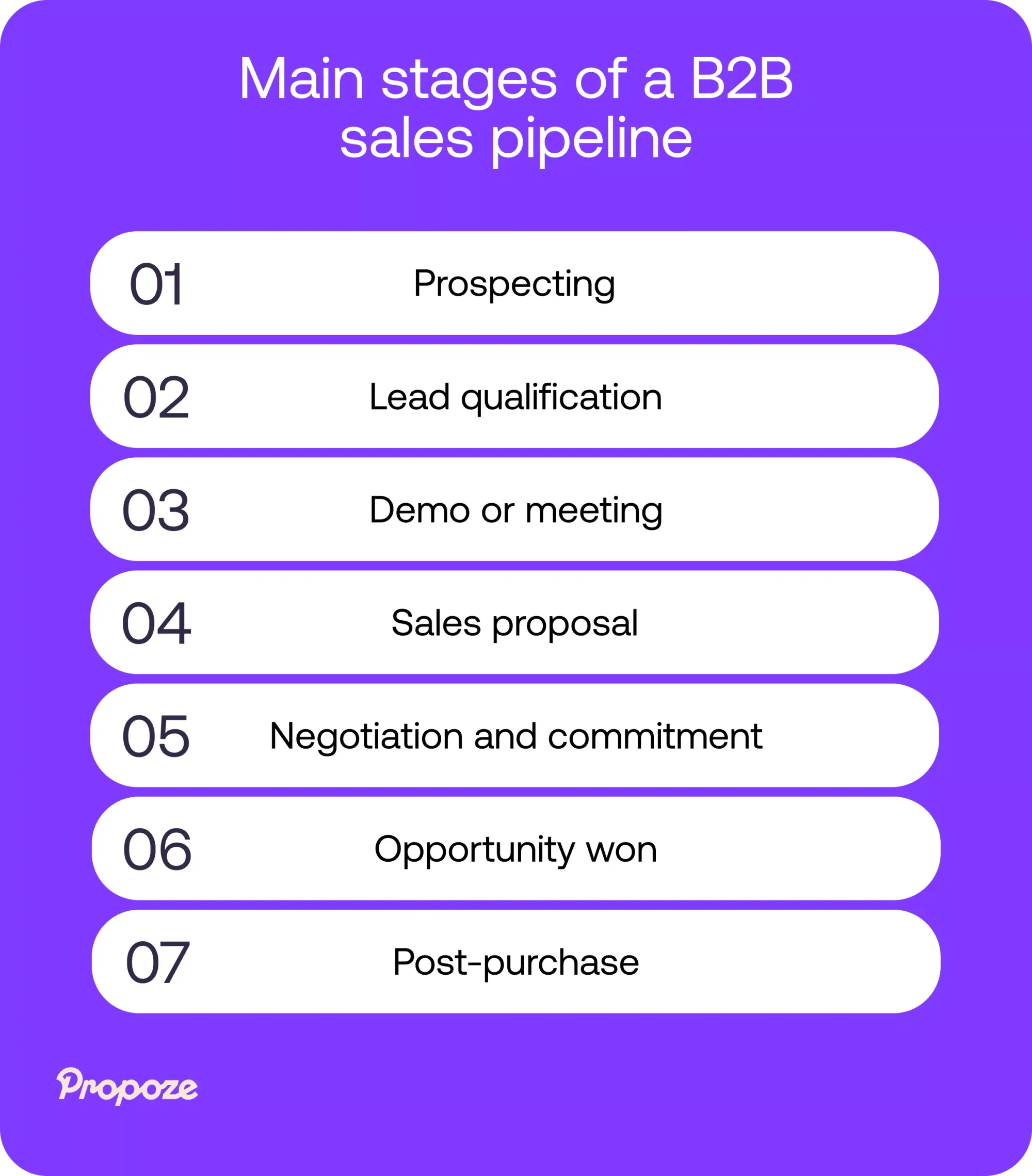
By understanding each stage’s requirements, sales reps can tailor their approach to match the customer’s needs and improve their chances of winning the deal.
Additionally, it can provide sales targets and forecasts, highlight the sales team’s performance metrics, and aid in sales team management by identifying opportunities for coaching and training.
In other words - there's much to gain by systemizing your efforts.
Ultimately, the sales pipeline is a powerful tool that enables sales teams to streamline their efforts, increase their sales efficiency, and maximize their revenue potential.
Importance of a sales pipeline
A sales pipeline is a crucial tool for any sales team, providing a visual representation of the sales process and helping to track progress, identify bottlenecks, and optimize sales strategies.
By having a clear understanding of the sales pipeline, sales teams can better manage their time, prioritize their efforts, and ultimately close more deals.
A well-structured sales pipeline allows sales professionals to see exactly where each potential customer is in the sales process.
This visibility helps sales teams to focus their efforts on the most promising leads, ensuring that no opportunity is overlooked. Additionally, a sales pipeline can highlight areas where deals are getting stuck, enabling sales managers to address these bottlenecks and streamline the sales process.
Moreover, a sales pipeline provides valuable data that can be used to forecast future sales and set realistic sales targets. By analyzing the pipeline, sales leaders can identify trends and patterns, making it easier to predict future revenue and allocate resources effectively.
In essence, a sales pipeline is a strategic asset that can drive sales performance and growth.
How to design a sales pipeline for your business
Designing B2B sales pipelines is a critical process that requires careful planning, analysis, and execution.
Here are some key steps you can take to design pipeline stages that work for your business.
Step #1: Understand your customer's journey
Before designing your pipeline, you need to have a clear understanding of your customer's buying journey. This includes identifying their pain points, needs, and motivations at each stage of the process.
Step #2: Define your pipeline stages
Once you understand your customer’s journey, you can define each sales pipeline stage of your B2B sales pipeline. Typically, sales pipelines consist of seven sales pipeline stages, including lead generation, qualification, proposal, negotiation, and closing.
Depending on your business, you may need to add or remove stages to fit your specific sales process.
Step #3: Establish criteria for each stage
Each stage of the pipeline should have specific criteria that determine when a lead moves from one stage to the next.
For example, to move a lead from the qualification stage to the proposal stage, they may need to meet certain qualification criteria, such as having a specific budget or timeline.
Step #4: Assign responsibilities
Determine who is responsible for each stage of the pipeline. This can include sales teams, your marketing team, or other stakeholders in suspect company.
Step #5: Identify potential roadblocks
Identify potential roadblocks that could prevent leads from moving through the pipeline, such as objections or competitors. Determine how you can overcome these roadblocks and create strategies to address them.
Step #6: Monitor and measure performance
Regularly monitor and measure your pipeline's performance, including conversion rates, deal velocity, and deal size. Use this data to optimize your sales pipelines and improve your sales performance over time.
Remember, designing a B2B sales pipeline is an ongoing process that requires regular evaluation and optimization. By following these steps, you can create a pipeline that helps you win more deals, increase revenue, and grow your business.
P.S. You'll find the most important metrics you need to track further in this post.
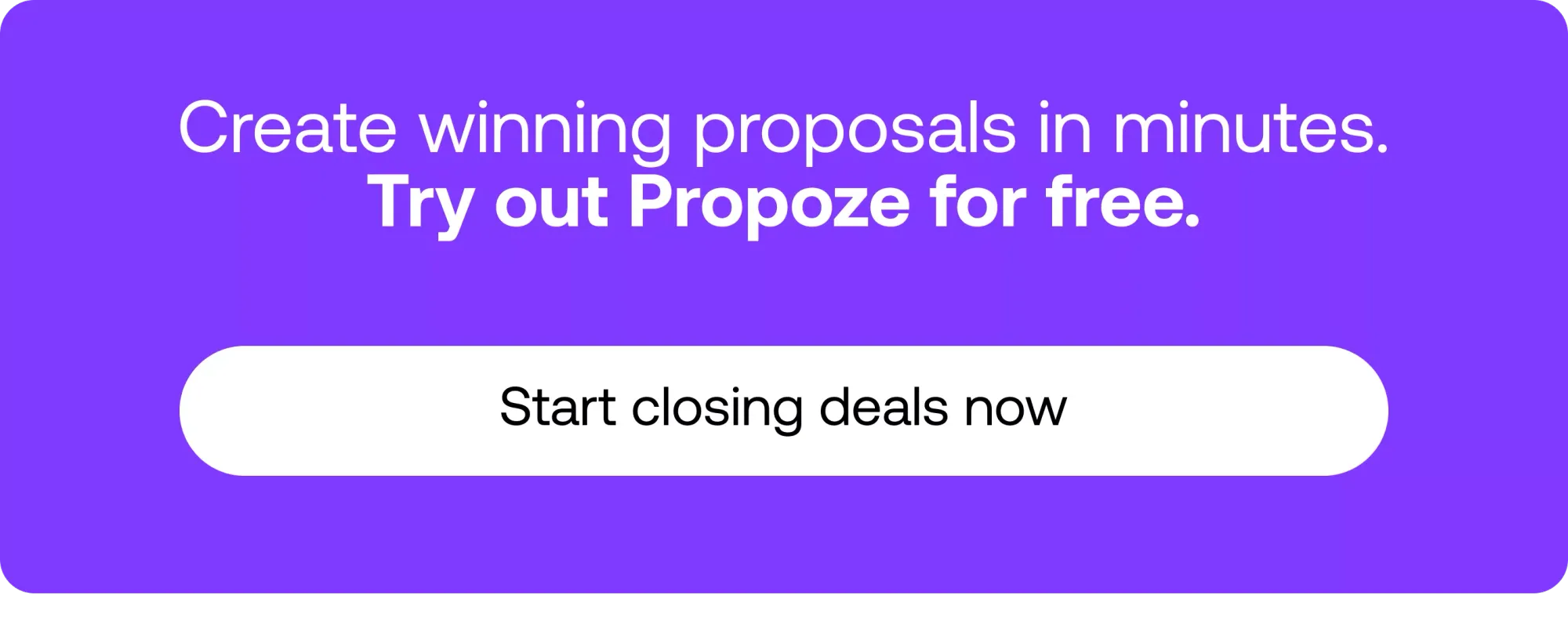
Define your sales process
Defining your sales process is essential to creating an effective sales pipeline. This involves identifying the specific stages that a prospect goes through from initial contact to closing the deal.
By breaking down the sales process into smaller, manageable stages, sales teams can better understand the needs of their prospects and tailor their sales efforts accordingly.
A well-defined sales process provides a clear roadmap for sales teams, ensuring that every step is accounted for and nothing is left to chance. It starts with the initial contact, where potential customers are first introduced to your product or service.
From there, the process moves through various stages such as lead qualification, proposal, negotiation, and finally, closing the deal.
By clearly defining each stage, sales teams can develop targeted strategies for moving prospects through the pipeline.
For example, during the lead qualification stage, sales reps can focus on identifying the most promising leads based on specific criteria. In the proposal stage, they can tailor their presentations to address the unique needs and pain points of each prospect.
This structured approach not only improves efficiency but also increases the likelihood of closing deals.
Calculate the opportunities you need to hit your goals
To calculate the opportunities you need to hit your goals, you need to understand your sales targets and the average deal size of your sales pipeline. By dividing your sales targets by the average deal size, you can determine the number of opportunities you need to close to reach your goals.
This will help you to prioritize your sales efforts and focus on the most promising leads.
Start by setting clear sales targets for your team. These targets should be specific, measurable, and aligned with your overall business objectives. Once you have your targets, calculate the average deal size by dividing the total revenue generated by the number of closed deals. This will give you a benchmark for how much revenue each deal typically brings in.
Next, divide your sales targets by the average deal size to determine the number of opportunities you need to close.
For example, if your sales target is $1 million and your average deal size is $50,000, you’ll need to close 20 deals to hit your target. This calculation helps you to understand the volume of opportunities required and allows you to allocate resources effectively.
By knowing the number of opportunities needed, you can prioritize your sales efforts and focus on the leads that are most likely to convert. This strategic approach ensures that your sales team is working efficiently and effectively towards meeting their goals.
Create a sales pipeline template
Creating a sales pipeline template can help to streamline your sales process and ensure that all leads are treated consistently.
1️⃣ Prospecting — This is the initial stage of the sales process, where sales teams identify and contact potential customers. The goal is to fill the pipeline with qualified leads who have a genuine interest in your product or service.
2️⃣ Lead qualification — This stage involves qualifying leads to determine whether they are a good fit for your product or service. Sales reps use criteria such as budget, authority, need, and timing to assess the potential of each lead.
3️⃣ Meeting/demo — This stage involves meeting with the prospect to demonstrate your product or service and answer any questions they may have. A well-executed demo can showcase the value of your offering and address any concerns the prospect might have.
4️⃣ Proposal — This stage involves presenting a formal proposal to the prospect, outlining the terms and conditions of the sale. The proposal should be tailored to the prospect’s needs and highlight the benefits of your solution.
5️⃣ Negotiation/commitment — This stage involves negotiating the terms of the sale and securing a commitment from the prospect. Effective negotiation strategies can help to overcome objections and reach a mutually beneficial agreement.
6️⃣ Closing the deal — This is the final stage of the sales process, where the sale is closed and the prospect becomes a customer. Ensuring a smooth transition from prospect to customer is crucial for long-term success.
By using a sales pipeline template, sales teams can ensure that all leads are treated consistently and that the sales process is followed in a logical and efficient manner. This consistency helps to improve conversion rates and ensures that no opportunities are missed.
7 must-have B2B sales pipeline stages
A successful sales pipeline consists of several stages that guide your leads toward becoming customers. Here are seven stages you should include in your pipeline.
#1 Prospecting stage: Filling your B2B sales pipeline
Prospecting is the foundation of your B2B sales pipeline, where you identify and engage potential leads who could benefit from your product or service. The goal here is to fill your pipeline with qualified prospects who are a good fit for your offering.
How to maximize your prospecting efforts:
- Use advanced tools for prospecting
- LinkedIn Sales Navigator: Leverage this platform to zero in on your target market. Use filters to find decision-makers based on job titles, company size, or industry. Advanced search features help you focus on prospects who meet your ideal customer profile.
- Email automation tools (e.g., Mailshake, HubSpot CRM): Personalization is key. Use automation to schedule personalized email campaigns at scale, helping you reach more prospects without losing the human touch. Schedule automated follow-ups to maintain consistent communication.
- Personalized cold outreach that converts
- Forget about mass cold emails. Instead, focus on tailored messages that directly speak to the recipient's pain points. Mention their company news, recent product launches, or specific challenges you know they're facing. A personalized message stands out among generic sales emails.
- Here's a pro tip: Use insights from LinkedIn to reference shared connections or professional milestones, making your outreach feel less "cold."
- Engage in networking and industry events
- Whether physical or virtual, networking remains one of the best ways to prospect. Build relationships at industry conferences, webinars, or even on social platforms like Twitter Spaces (now X). After the event, add contacts to your CRM and follow up with personalized messages referring to your conversation or event topic.
All this sounds great, but you'll need some tangible advice that you can work with. Here's a table we crafted to help you decide when to use which prospecting method.
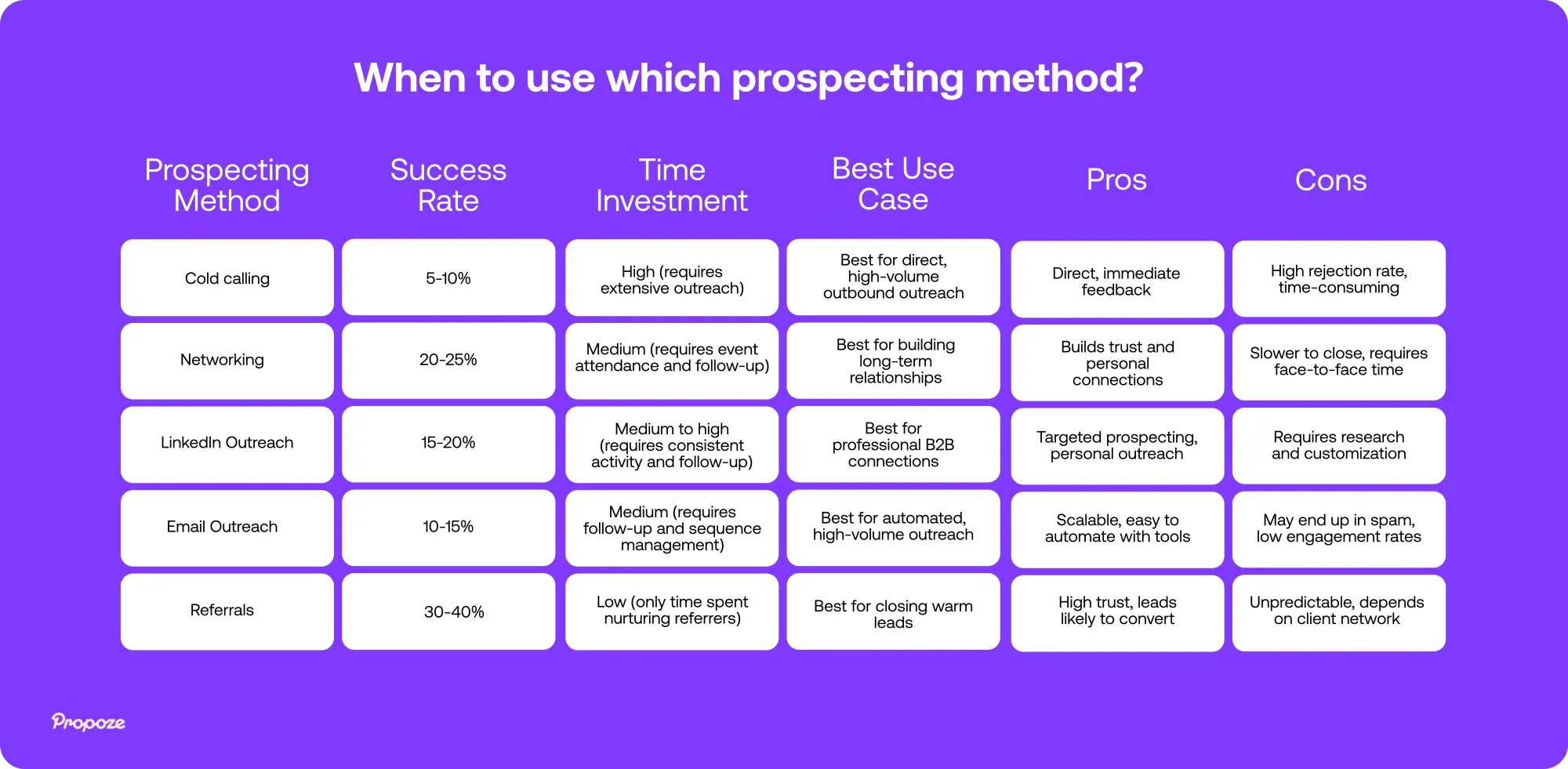
Qualify your leads efficiently with BANT and ANUM
During prospecting, it's essential to know who to pursue and who to let go. Using lead qualification frameworks like BANT and ANUM ensures that your outreach is focused on high-quality leads that are more likely to convert.
- BANT:
- Budget: Do they have the financial resources to buy your solution?
- Authority: Are you speaking to someone who can make purchasing decisions?
- Need: Do they have a clear problem that your product can solve?
- Timing: Is the prospect ready to implement a solution now?
- ANUM:
- Authority: Prioritize reaching decision-makers first.
- Need: Focus on leads with pressing, identifiable needs.
- Urgency: Determine if there's an immediate issue requiring quick action.
- Money: Evaluate whether the budget is available now, or in the near future.
By using these frameworks, your sales team can quickly prioritize hot leads, avoiding time wasted on prospects who are unlikely to convert.
Use CRM and sales tools to track your leads
Keep all your interactions organized with a CRM system like HubSpot or Salesforce.
These platforms enable you to track every touchpoint with your leads, ensuring that no prospect falls through the cracks. You can also generate custom reports to track KPIs like email open rates, response rates, and the number of qualified leads added to the pipeline each month.
Pro tip: Focus on consistency
Success in prospecting isn’t about sending one message and expecting results.
On average, it takes 7 touchpoints for a prospect to respond. Ensure that your team follows a structured outreach cadence with scheduled follow-ups, leveraging email automation tools to stay persistent without overwhelming the prospect.
#2 Lead qualification stage: Prioritizing the right opportunities
Lead qualification is the second stage in your B2B sales pipeline, where you identify which leads have the highest potential to become customers. Qualifying leads ensures your sales team focuses on prospects that are more likely to close, saving time and resources.
Different types of leads to qualify:
- Inbound leads: These are individuals who have already interacted with your website by signing up for a demo, downloading resources, or filling out a contact form. They’ve shown intent, making them a good starting point for further qualification.
- Marketing qualified leads (MQL): These leads have shown consistent interest in your product through behaviors such as engaging with your marketing materials or signing up for email lists. However, they might not yet be ready for sales outreach.
- Sales qualified leads (SQL): These are the most valuable leads. SQLs demonstrate clear intent to purchase and meet key criteria such as budget and authority. These leads are ripe for further engagement.
- Target account leads: These leads are part of Account-Based Marketing (ABM) strategies where your team focuses on high-value accounts. They often come from key industries or companies identified as ideal clients.
- Event leads: Generated from conferences, webinars, or industry events, these leads require additional nurturing but can be great opportunities when followed up with personalized outreach.
Lead qualification using the BANT framework:
One of the most effective ways to qualify leads is the BANT framework, which stands for Budget, Authority, Need, and Timing. Here's how each element works:
- Budget: Ensure that your lead has the financial resources to invest in your solution. During qualification, ask, "What kind of budget have you set aside for this project?"
- Authority: Identify whether you're speaking with the decision-maker. Asking a question like, "Who else will be involved in the purchasing decision?" ensures you’re engaging the right person.
- Need: Understand the lead’s pain points and how urgently they need a solution. Ask, "What challenges are you hoping to solve with our product?"
- Timing: Determine whether the prospect is ready to make a purchase. The timing element helps prioritize leads who need a solution soon over those still in the research phase. Questions like, "When are you looking to implement this solution?" help qualify based on urgency.
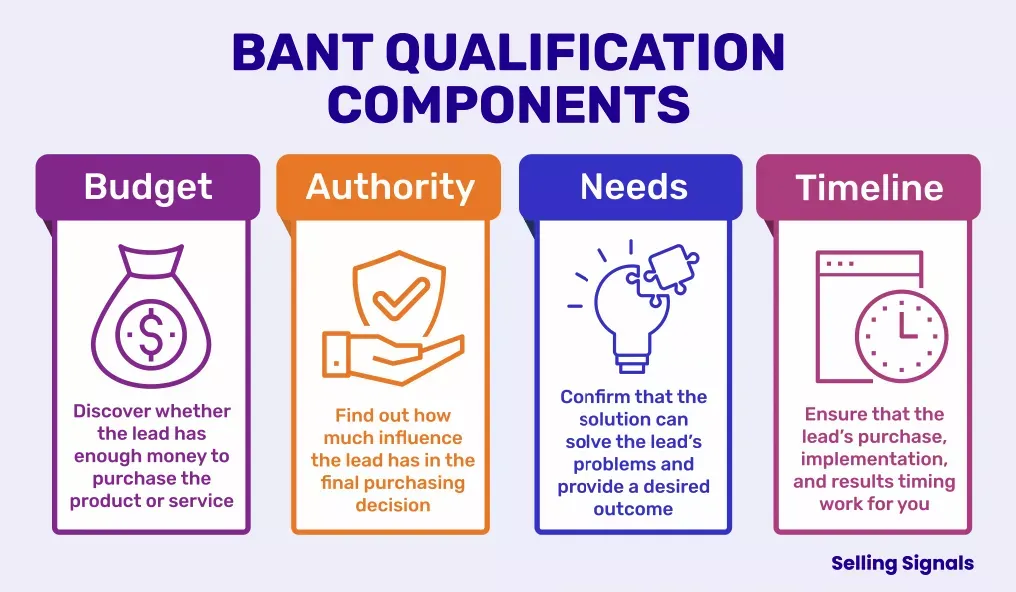
Using lead scoring to automate the process:
To make your qualification process scalable, implement lead scoring using tools like HubSpot or Salesforce. Assign a score to each lead based on their interactions with your business (e.g., visiting your pricing page, downloading whitepapers, attending webinars). Leads that reach a certain score threshold are passed to sales as sales qualified leads.
Here are some KPIs to measure lead qualification success:
- Lead-to-SQL conversion rate: Measure how many marketing leads successfully become sales qualified leads.
- Lead response time: Aim to respond to inbound leads within the first 5 minutes, as this increases conversion rates by up to 21x.
ANUM framework for fast-tracking lead qualification:
In time-sensitive sales environments, the ANUM framework can help prioritize hot leads by focusing on:
- Authority: Are you engaging with a decision-maker or someone with influence?
- Need: Does the prospect have an immediate problem that your solution addresses?
- Urgency: How quickly do they need a solution? Prospects with immediate needs should be prioritized.
- Money: Do they have the financial capacity to move forward now?
By using the ANUM framework, your team can fast-track high-priority leads while ensuring that all qualified leads meet critical buying criteria.
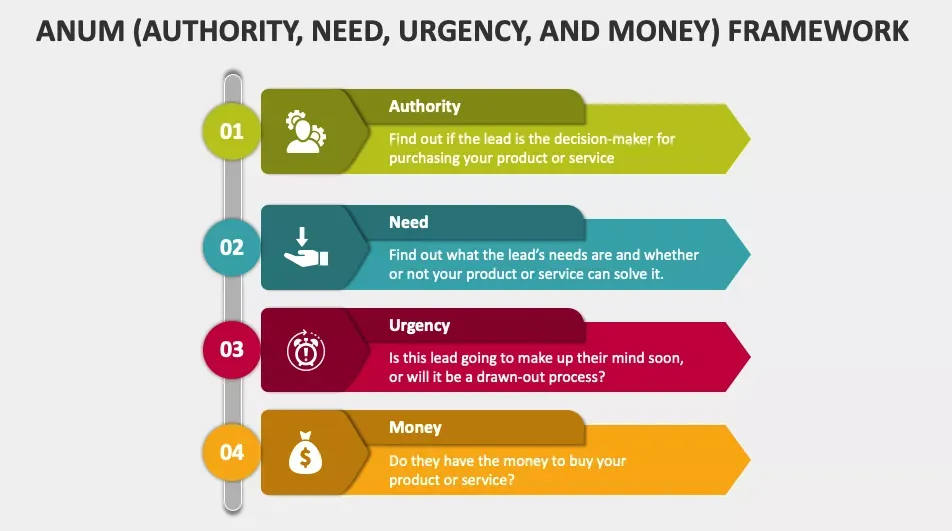
Discovery calls: Qualifying leads the right way:
The best way to qualify leads is through discovery calls. These conversations help sales reps assess the prospect’s needs, budget, and timeline. Here are some of the best discovery questions to use:
- "What’s the main challenge you're facing right now in [specific area]?"
- "Have you considered other solutions, and how do you see ours fitting in?"
- "What does success look like for your team?"
You're in luck because we've created a comprehensive list of discovery call questions that will help you nail this lead qualification stage.
#3 Demo or meeting stage: Presenting solutions that align with your lead's pain points
The demo or meeting stage is where your qualified lead gets to see your product or service in action.
This is your chance to showcase how your offering solves their unique problem and aligns with their business goals. By tailoring your demo, you can effectively demonstrate value, address objections, and move your prospect further down the pipeline.
Here are some key strategies for a high-impact demo:
- Customization is key
A generic demo doesn’t cut it. You must tailor your presentation to the lead's specific pain points and industry challenges. Use the insights gathered during the lead qualification and discovery stages to craft a demo that speaks directly to their needs.
For example, if you're demoing software for a manufacturing company, focus on how your tool optimizes operational efficiency and reduces downtime. - Tell a story with customer use cases
During your demo, use real-life examples and case studies from existing customers. Walk the lead through how other companies in similar industries have used your product to solve specific challenges. For instance, you can share how your SaaS platform helped a client reduce their project completion time by 30%, illustrating tangible benefits. - Address objections head-on
A successful demo isn’t just about highlighting features; it’s also about addressing potential concerns. Common objections might revolve around price, compatibility, or ease of implementation. Be ready to answer these objections with clear, factual information. For example, “I understand that you're concerned about integrating our CRM with your existing system—our open API allows seamless integration with most platforms.” - Provide a clear call-to-action (CTA)
End every demo with a strong next step. Whether it’s scheduling a follow-up meeting or requesting a product trial, make sure your prospect knows exactly what action to take. “Let’s schedule a follow-up next week to discuss your implementation plan,” gives them a concrete action to move forward with.

Please check the image above for a more detailed breakdown of a demo.
Here are the best practices for demo success:
- Personalize the experience
Research the lead's business beforehand and demonstrate how your product or service aligns with their business objectives. Use custom visuals and industry-specific data in your demo presentation to make it feel personalized. Prospects are much more likely to engage when they feel like the demo is created just for them. - Highlight benefits over features
Prospects aren’t just interested in what your product does—they want to know how it helps them solve problems. Focus on the benefits of your product, such as increasing productivity, streamlining workflows, or reducing costs. For example, instead of explaining how your software automates reporting, emphasize how it saves your client’s team 10 hours a week on manual tasks. - Interactive demo sessions
Engaging your prospects during the demo keeps them involved. Let them ask questions or even test out the product live. Tools like Demodesk or Zoom allow you to give control of the demo to your prospect, making it a collaborative experience. - Utilize customer feedback for continuous improvement
Gathering feedback from current customers about their demo experience can be invaluable. Interview your top clients to understand what resonated most with them during the demo, and apply these insights to future presentations. Adjust your value proposition based on this feedback.
Use these tools to perfect your demo process:
- Demodesk: This platform allows you to deliver a tailored, interactive product demo with ease, especially for SaaS or software-based solutions. You can pre-upload materials, share your screen seamlessly, and track interactions in real time.
- Zoom or Google Meet: For remote demos, these platforms offer an easy way to present your product while keeping prospects engaged through live chat and screen sharing.
- SlideDecks: Use visually compelling slides that illustrate key points without overwhelming your prospect with too much text. Always keep slides clear, with focus on value, not product features.
Here's a pro tip: focus on metrics & ROI during the demo!
When showing your solution, don't just focus on its functionality—emphasize the return on investment (ROI). Demonstrate how your product can help improve their metrics. For example, "Our solution increased one client's lead conversion rate by 40% within the first quarter."

#4 Sales proposal stage: Crafting a compelling offer to close the deal
At the sales proposal stage, your goal is to translate all the work done so far into a clear, compelling offer that resonates with your prospect’s needs and demonstrates the unique value of your solution.
This is where the specifics of pricing, deliverables, and timelines are formalized.
Key elements of a winning sales proposal:
1) Tailor the proposal to your prospect’s pain points
Your proposal should reflect a deep understanding of the prospect’s specific challenges and business goals. Refer back to the pain points uncovered during the discovery call or demo. By aligning your proposal directly with their needs, you’re not just selling a product; you’re offering a solution. For instance, if your lead is struggling with managing multiple accounts, your proposal should emphasize how your product improves client management efficiency.
2) Offer multiple pricing tiers
Clients appreciate flexibility. Present tiered pricing options that allow them to choose a package that fits their needs and budget. For example, offer Basic, Pro, and Enterprise packages, each with a clear breakdown of services and value. Be transparent about any additional costs or fees to avoid surprises. Competitors like FunnelClarity use tiered pricing to offer prospects control over what they pay for, while still positioning themselves as a premium provider.
3) Include case studies and social proof
Social proof plays a critical role in building trust. Include short case studies from similar clients that highlight how your product or service delivered tangible results, such as increasing lead conversion rates by 30% or reducing operational costs by 20%. Storytelling connects with prospects emotionally and builds credibility. Competitors like Concentrix excel in providing real-world examples that prospects can relate to, helping to close deals faster.
4) Leverage proposal software for engagement tracking
Tools like Propoze or PandaDoc allow you to track how long each section of your proposal is viewed and when it’s opened. This data gives you actionable insights for follow-up. For example, if a prospect spends the most time on the pricing section, it might indicate hesitancy around costs, signaling that you should address pricing concerns in your follow-up email. HubSpot excels at using data-driven insights to adjust sales strategies in real time, helping reps prioritize hot leads.
5) Emphasize ROI and tangible benefits
When you present your pricing, don’t just focus on costs—highlight the return on investment (ROI). Use data and metrics to show how your solution can increase productivity, sales, or reduce costs. For example: "Our CRM solution will reduce your sales cycle by 15% and increase your team's efficiency by 20 hours per week." Competitors like FunnelClarity focus on this to give clients a clear picture of the long-term value of their investment.
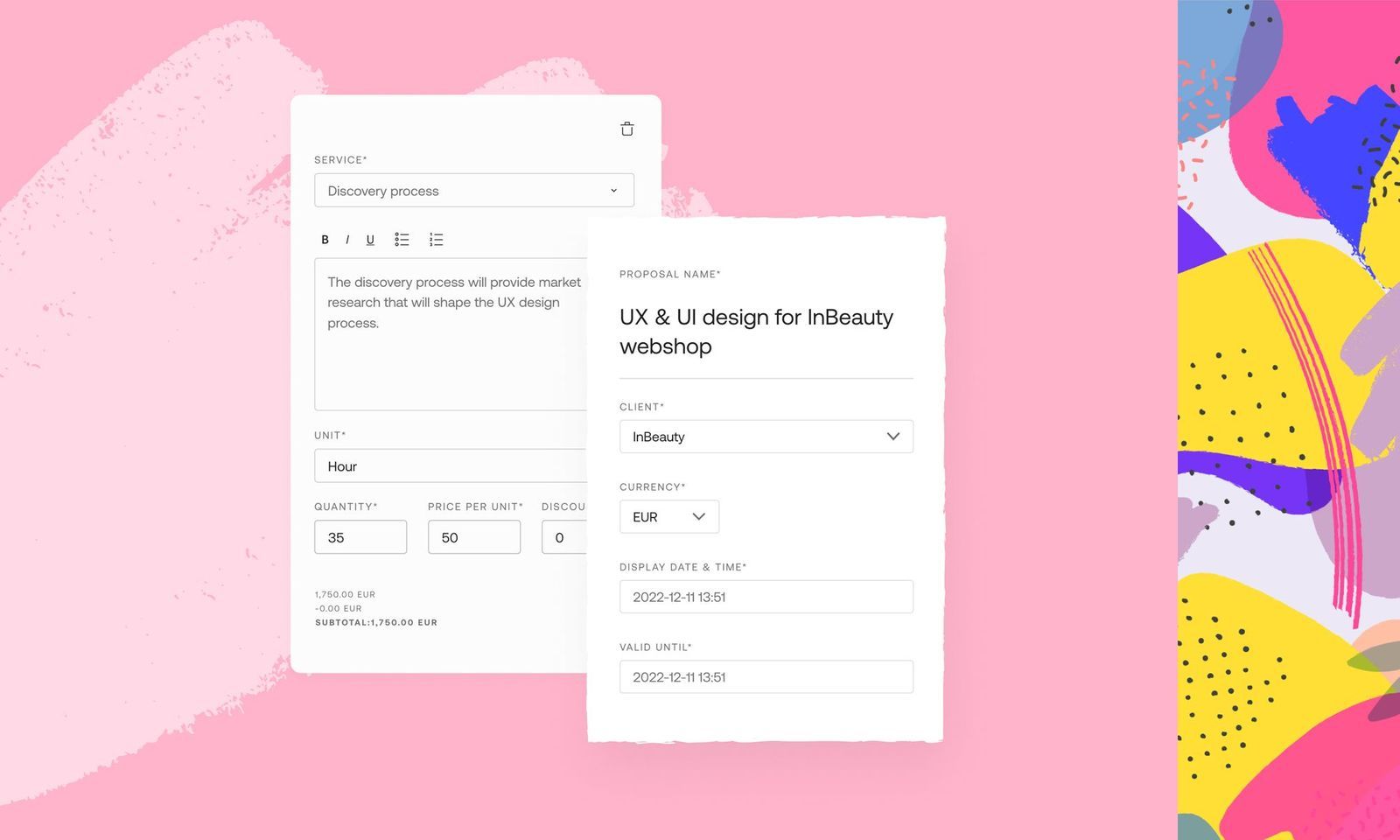
Metrics and Tools to Improve Your Sales Proposal:
1) Track proposal engagement
Use tools like Propoze or PandaDoc to track when the prospect opens the proposal, how long they spend on each section, and whether they revisit specific details like pricing or timelines. This data can help you time your follow-ups more effectively.
2) Proposal conversion metrics
Aim for a 30-40% conversion rate—out of every 10 proposals sent, at least 3 to 4 should close into deals. By monitoring this metric, you can refine your proposal strategies over time.
Here's a real world example.
Imagine you’re pitching a SaaS marketing automation tool to a mid-sized eCommerce business. Instead of sending a generic proposal, dive deep into the client’s customer acquisition challenges.
Use case studies from other eCommerce clients to demonstrate how your tool increased their conversion rates by 25% and boosted revenue. Customize the pricing section to include different levels of service, from basic email automation to enterprise-level omnichannel marketing.
This approach, paired with real-time engagement tracking, makes it easier to close the deal by showing immediate value.
#5 Negotiation stage (+ closing): Guide the conversation to a win-win outcome
The negotiation stage in your B2B sales pipeline is where deals are won or lost. Your goal here is not just to close a sale but to craft an agreement that provides value to both you and the client.
Negotiating effectively requires clear communication, strategic offers, and a win-win mindset. At this stage, you’ll address any remaining concerns, finalize terms, and ultimately gain your prospect’s trust to move forward.
During this stage, you'll need to pay attention to a few things. Here's the list:
- Address any remaining concerns and objections the lead may have
- Negotiate terms that work for both parties
- Be clear and transparent about all aspects of the sale
- Provide great customer service and support throughout the entire process
Here are 4 key negotiating tactics
1) Address last-minute objections with transparency
As you approach the close, your prospect may raise final concerns, especially around pricing, timeline, or the perceived value of your product. Respond to these with a transparent, client-focused approach.
- Use framing tactics: Position your offer as a solution to their specific pain points rather than just a price tag. For example, "While our pricing might be higher than competitors, our clients typically see a 40% increase in lead conversion within the first three months."
- Handle objections directly: If your prospect raises price objections, use anchoring to your advantage. Present a higher initial offer, then negotiate down to the final price, making it feel like a concession.
2) Leverage advanced negotiation strategies
- BATNA (Best alternative to a negotiated agreement): Know your alternatives if the deal doesn’t close. This keeps you negotiating from a place of strength, not desperation.
- Give-and-take concessions: When the client pushes for a discount, offer a concession in exchange for something of value, like a longer-term contract or faster payment terms.
For example: “We can offer a 10% discount if you sign for 12 months instead of 6.” This strategy ensures that both sides leave the table satisfied.
3) Use data and metrics to strengthen your proposal
Highlight ROI and value metrics to make the prospect feel more comfortable with the price. Prospects want to understand what they’re getting for their investment.
- Quantify your benefits: For example, "Our CRM system will streamline your sales process, reducing manual input by 30 hours per month, which translates into $15,000 in labor savings over the next year." This helps build a strong case for the value you’re providing.
- Track success with closing metrics: Use tools like Propoze to measure the effectiveness of your negotiation. Tracking metrics like close rate and negotiation cycle length helps you improve future negotiations.
4) Highlight long-term value, not just price
Often, price is the main objection. Shift the conversation to the long-term value your product or service will deliver. Focus on key metrics like cost savings over time, efficiency improvements, or customer satisfaction.
Here's a real world example.
Let's say you're selling a SaaS platform to a mid-sized company that’s concerned about scalability. They love your product, but they hesitate due to the cost of scaling as their business grows.
Instead of dropping the price, offer them a tiered pricing structure where they can upgrade based on usage.
This not only solves their price concern but positions you as a long-term partner who grows with their business.
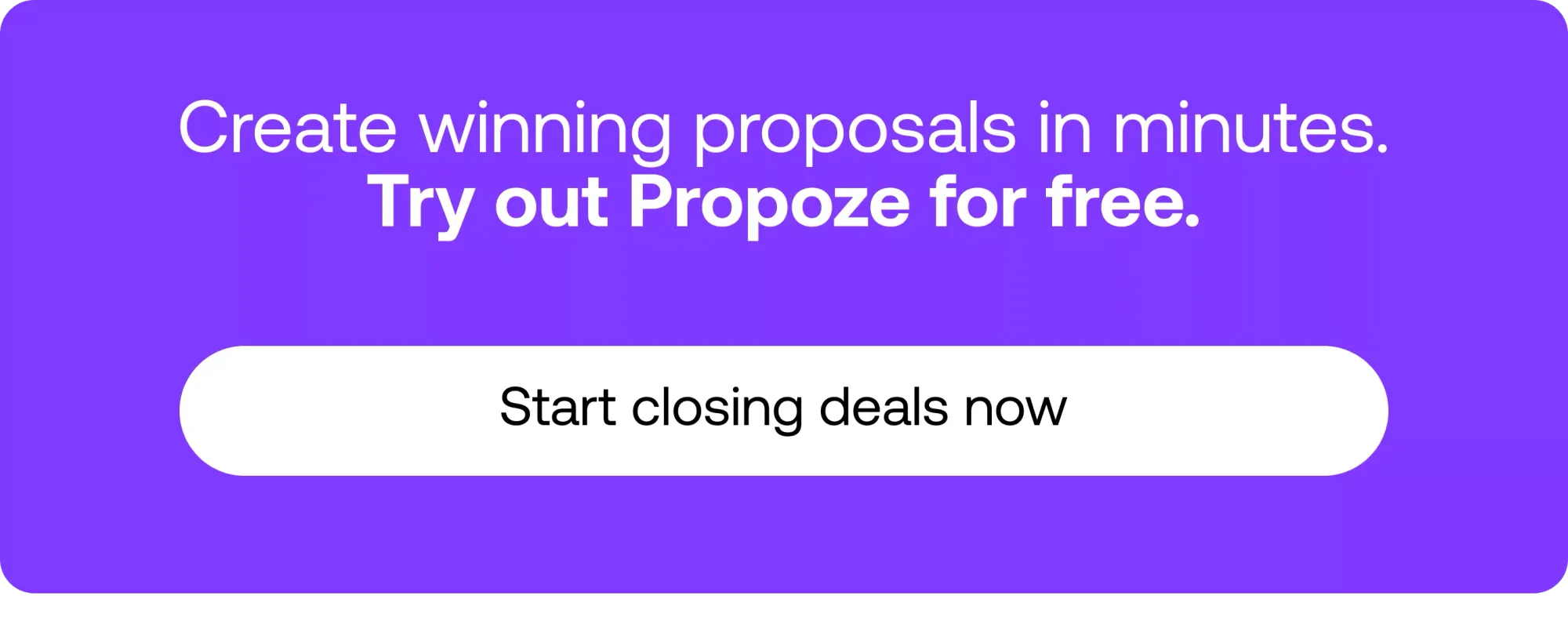
#6 Winning the deal
Successfully closing a deal is a major milestone in your B2B sales pipeline, but it’s just the beginning of your relationship with your customer. The key to continued success is to focus on customer satisfaction and long-term retention.
This means going beyond simply delivering the product or service—it's about ensuring your customer gets maximum value and stays engaged with your brand.
5 steps to build long-term success after closing
1) Deliver on promises and over-deliver
The moment your client says yes, it’s crucial to over-deliver on the promises made during the sales process. Ensure that deliverables are met ahead of schedule or go the extra mile in terms of customer service to exceed expectations.
For example, if you've committed to a 4-week onboarding, try to finish it in 3 weeks and surprise the customer with an additional feature.
2) Structured onboarding for immediate value
A strong onboarding process can make all the difference. Ensure your client is trained and fully supported in using your product. This could include:
- Personalized tutorials or webinars tailored to the client’s specific needs.
- Assign a dedicated success manager to check in during the first month.
- Use customer success tools like Net Promoter Score (NPS) to gauge satisfaction early on and address concerns.
4) Follow-up and maintain engagement
Regular check-ins should become part of your routine post-sale. Follow up at regular intervals—1 month, 3 months, 6 months—to see how your client is progressing and if they need any additional support.
Use tools like customer satisfaction surveys to gather feedback, as this will help you continuously improve your product and client experience.
5) Turn customers into advocates
Once your customer is satisfied, ask for referrals or testimonials. Offer incentives such as discounts or extra features for clients who refer new customers to you. This not only builds social proof but strengthens your relationship with existing clients.
6) Provide ongoing support and communication
Even after your product is delivered, continue to provide support. Keep your clients informed about new features, upcoming updates, or exclusive offers.
Here's a real word example.
Let’s say you’ve just closed a deal with a mid-sized software company for your marketing automation platform.
After the deal is closed:
- Offer a personalized onboarding session where you walk them through every feature, using their specific industry challenges as examples.
- After 3 months, follow up to ask how they’re using the platform. Offer them tips for maximizing efficiency and introduce them to new features.
- Ask them to share a testimonial or case study, incentivizing them with a discount on their subscription for every referral they make.
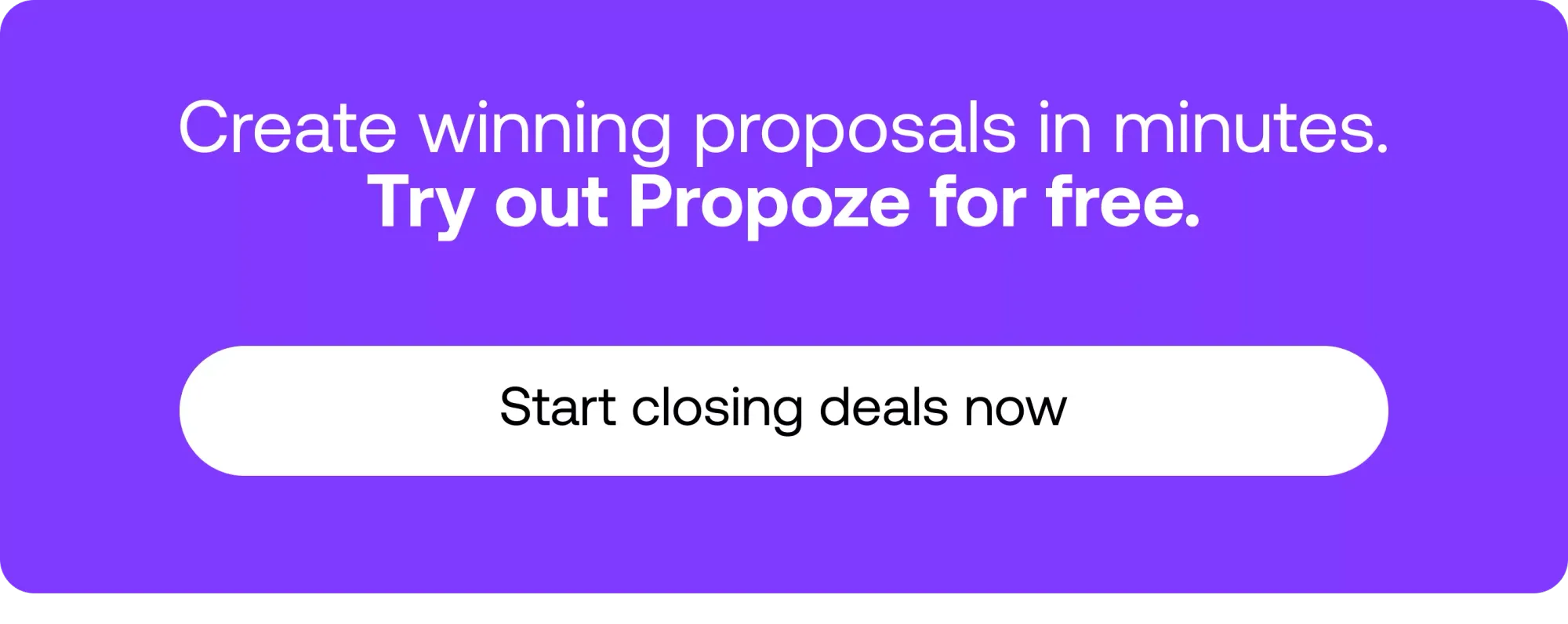
#7 Post-purchase retention stage: Creating lasting customer success
The final stage of your B2B sales pipeline is the post-purchase retention stage, where your focus shifts to keeping your customers satisfied and loyal over time.
Winning the deal is just the beginning—retaining customers and ensuring they continue to find value in your offering is what will drive long-term business growth. It’s not only about preventing churn but about turning customers into advocates who promote your brand and generate referrals.
5 strategies for maximizing post-purchase retention
1) Deliver exceptional customer success and onboarding
The moment your customer signs on, begin delivering onboarding support that ensures they can fully utilize your product or service. Introduce a customer success team to offer one-on-one support, guiding them through any learning curves and ensuring they achieve their goals.
- Here's a pro tip: Use customer satisfaction metrics like Net Promoter Score (NPS) or Churn Rate to measure the effectiveness of your onboarding process and customer satisfaction. For example, after 30 days, ask clients, "How likely are you to recommend us to a colleague?"
2) Proactive customer engagement and follow-up
Stay ahead of potential issues with proactive communication. Schedule regular check-ins (e.g., monthly or quarterly business reviews) to track their progress, discuss new goals, and introduce additional services as their needs evolve.
- Here's an example: A SaaS company might schedule a QBR every quarter to ensure clients are leveraging all features of their platform, while also providing suggestions on how to optimize usage for better results.
3) Offer personalized upsell opportunities
Upselling should be based on your customers' specific needs. Track their usage data and reach out when you identify opportunities to offer additional features or premium packages. Offering exclusive deals to existing customers can help incentivize them to expand their engagement with your product or service.
- Example: If a customer is using 70% of your product features, offer an upsell package with customized training or access to advanced features that will directly benefit their business.
4) Customer advocacy and feedback loops
Encourage satisfied clients to share testimonials, provide referrals, or contribute to case studies. Incentivize these actions by offering discounts, free services, or exclusive access to features. Collecting regular feedback from surveys or interviews will also help you improve your offering and address any pain points early.
- Here's a pro tip: Create a customer referral program where existing clients can earn rewards for introducing new leads. For instance, offer them a free month of service or a discount for every new client they refer.
5) Create a customer community
Help your clients feel more connected to your brand by building a customer community. Offer exclusive webinars, product training sessions, or networking events to foster a sense of belonging and encourage customer loyalty.
Here's a real world example.
Imagine you’ve closed a deal with a mid-sized marketing agency using your project management software.
After onboarding, your customer success manager schedules a 30-day check-in to ensure all team members are using the software efficiently. Based on the client’s feedback, you offer additional training on automation features they weren’t using, which helps them reduce admin work by 30%.
You also introduce them to advanced reporting tools as part of an upsell package. Finally, you ask for a testimonial showcasing their improved efficiency, and offer them a 10% discount on the next renewal in exchange for a referral.
Sales pipeline vs. sales funnel - what’s the difference
The terms "sales pipeline" and "sales funnel" are often used interchangeably, but they actually refer to two different things.
Here's how they differ.
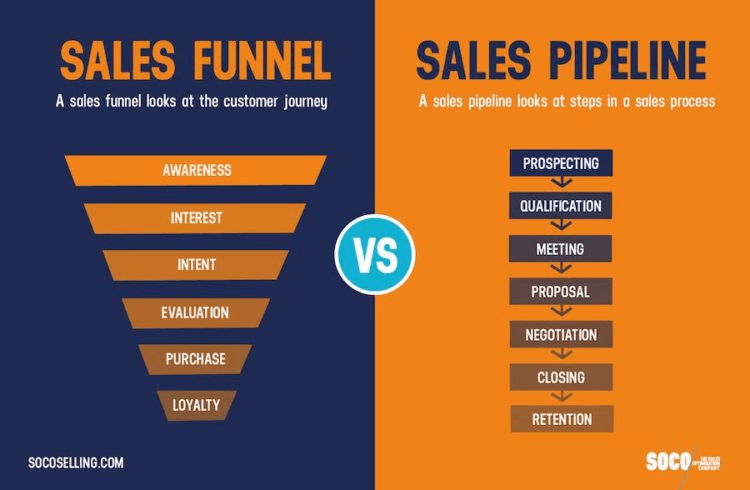
A sales pipeline is like a roadmap that guides you through each step of your selling process. It helps you keep track of where each potential customer is in the journey and what you need to do to keep things moving in the right direction. Think of it as a way to stay organized and focused so you can close more deals.
In contrast, a sales funnel is a bigger-picture view that covers the entire customer journey, from when they first learn about your business to the moment they make a purchase. It's a more comprehensive perspective that takes into account both marketing and sales activities.
Even though these terms may seem similar, there are some notable differences between them you need to understand. In short, while the pipeline is specifically tailored to the sales process, a funnel looks at the entire customer journey.
Knowing when and how to use both the sales funnel and sales pipeline will help you achieve your business goals more effectively.
Just a quick side note. Here's our detailed guide to sales efficiency that will help you get better sales results and move prospects faster through your sales pipeline.
Sales pipeline vs. marketing pipeline - what’s the difference
Both sales and marketing pipelines are important concepts in business, but still, they largely differ.
The sales pipeline, on the one hand, functions as a roadmap for potential customers that guides them through all stages of the sales process. It is a way to keep track of where your prospects are in their journey and what you need to do the move them closer to making a purchasing decision.
The marketing pipeline, on the other hand, focuses on the stages the leads go through before they even become a potential customer. In essence, it's a map for taking a lead from the point of first contact with you all the way to becoming a potential customer.
Usually, it goes hand in hand with strategies like inbound marketing, content marketing, lead nurturing, and similar.
You can notice that these two pipelines are connected. First, the lead needs to go through the marketing pipeline. Afterward, those same leads, now potential customers, go through all the sales pipeline stages, finally becoming paying customers at the very end.
Can a sales pipeline have more than 7 stages (and how does it fit into your sales process)
While the typical sales pipeline has 7 stages, it's not set in stone.
The number of stages you need in your sales pipeline will depend on your industry, sales cycle length, and the specific needs of your business.
So, the answer is yes, your sales pipeline can have more than 7 stages. But it can also have less than 7 stages. The key is to ensure that each stage aligns with your sales operations and supports your overall sales goals.
Don't add stages for the sake of it, but rather ensure that each stage is necessary and contributes to the success of your sales efforts.
P.S. Here's some recommended reading for you! We've studied and gathered the most impactful B2B sales trends in a single blog post. Give it a read and stay one step ahead of your competitors!
Which sales pipeline metrics should your sales team measure
When it comes to measuring the success of your sales pipeline, there are several key metrics that you should be tracking.
We'll go through all these metrics, so be sure to write them down somewhere as you continue.
Conversion rate
One important metric is conversion rate, which measures the percentage of leads that move from one stage of the pipeline to the next. This metric is essential for identifying potential bottlenecks in your pipeline and making data-driven decisions to optimize your sales process.
Conversion Rate = (Number of leads at Stage Y / Number of leads at Stage X) x 100%
Lead velocity
Another critical metric to track is lead velocity, which measures how long it takes for a lead to move from one stage of the pipeline to the next. This metric provides insights into the efficiency of your sales process and can help you identify areas where you can speed up the sales cycle.
Lead Velocity = (Number of leads at Stage X - Number of leads at Stage Y) / (Number of days between Stage X and Stage Y)
Average deal size
Average deal size is another important metric to consider, as it measures the average revenue generated from each closed deal. This metric can be used to identify trends in your sales pipeline and to determine which types of deals are most profitable for your business.
Average deal size = Total revenue generated / Number of closed deals
Sales cycle length
In addition, it's essential to track sales cycle length, which measures the time it takes to move a lead from the first stage of the pipeline to a closed deal. This metric can help you identify opportunities to shorten the sales cycle and close deals more quickly.
Sales cycle length = Date deal closed - Date lead entered pipeline
Win rate
Finally, tracking the win rate is crucial for evaluating the effectiveness of your sales team. This metric measures the percentage of deals that your sales teams are able to close successfully and can help you identify areas where your sales team may need additional training or support.
Win rate = (Number of closed-won deals / Total number of deals) x 100%
Closed lost deal and closed won deal
If you're a sales rep, you probably know these two terms down to the core. However, here's what these terms mean, in short:
- Closed-lost deal refers to any situation where a target account (prospect) formally declines to complete the sales process and make a purchase.
- Closed-won deal refers to any situation where a deal has been successfully closed and the prospect becomes your paying customer.
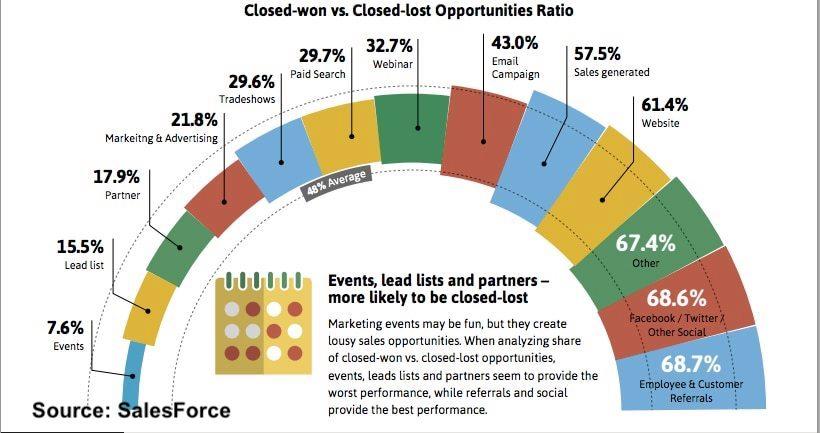
Start designing your sales pipeline
We've gone through all the stages of a sales pipeline, and hopefully, helped you understand how to design one for your business.
As you begin designing and implementing your own pipeline, keep in mind that you'll need to continuously evaluate and iterate to ensure it's completely in sync with your sales process.
There are tons of sales pipeline templates you can use, but if you want to create a pipeline that truly correlates with your sales processes, you may want to start from these seven stages. Of course, you can reduce or increase the number of stages as you see fit, but this should be your starting point.
Luckily, we can help you nail down the fourth stage (sales proposal) with ease. To help freelancers, small business owners, and sales reps across all industries, we've created Propoze - a block-based proposal software.
With Propoze, you can create stunningly beautiful proposals in minutes. Give it a try and let us know your thoughts!
And if you need help setting up your account or figuring out the best way to use Propoze, let us know at support@propoze.app!
Follow us on our LinkedIn, Twitter, and Instagram accounts! We post regularly on proposal and sales-related topics.